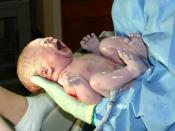By one month of age, every child should be showing awareness of sounds, turning (at
least with their eyes) towards voices or rattles. Most babies start making cooing sounds
by three months of age, and make several other different sounds (growling, laughing,
etc). By four months, babies should be able to hold a "conversation" without words
listening when you talk to them, then "talking" back at you. Of course, on any given day,
a baby might be tired, hungry, or just too interested in looking at your earrings or the
lights on the ceiling. But if you feel that your child is consistently distant or distracted,
this could be an early sign of an important problem.
Almost all babies make at least one consonant-vowel sound (such as "ma" or "ba") by 10
months of age. By 11 months, most will string two or more sounds together ("ma-ba-
ba"), often with some changes in pitch.
By 10 months, a baby should stop what she is
doing if you say "no" to her (don't expect her to remember the "no" for much longer than
a couple of seconds, though). They should enjoy word-movement games like pat-a-cake
and peek-a-boo. If you've been doing "bye-bye" for a few weeks, many 10-month-olds
can do it, at least some of the time, when you ask them to. Many, but not all, babies say
their first real word between 11 and 14 months of age. By "real word," I mean a sound
that they use on their own (not imitating) to indicate the same thing every time, even if
the sound is not a word that anyone else ever uses (such as "doose" to mean "juice").
Often, the first word is "mama" or "dada." Most one-year-olds communicate well, even
without words: They let you know what they...


